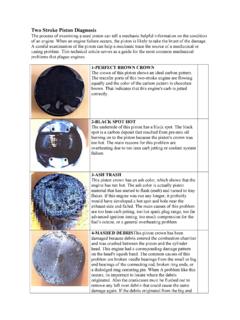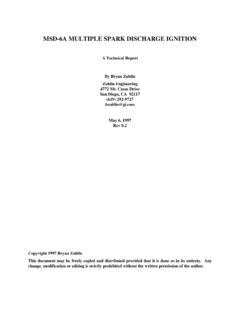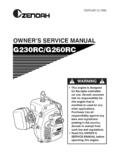Transcription of Basic 2 stroke Tuning - Albany City Kart Club
1 Basic 2 stroke Tuning Changing the power band of your dirt bike engine is simple when you know the basics . A. myriad of different aftermarket accessories is available for you to custom tune your bike to better suit your needs. The most common mistake is to choose the wrong combination of engine components, making the engine run worse than stock. Use this as a guide to inform yourself on how changes in engine components can alter the powerband of bike's engine. Use the guide at the end of the chapter to map out your strategy for changing engine components to create the perfect power band.
2 TWO- stroke PRINCIPLES. Although a two- stroke engine has less moving parts than a four- stroke engine, a two- stroke is a complex engine because it relies on gas dynamics. There are different phases taking place in the crankcase and in the cylinder bore at the same time. That is how a two- stroke engine completes a power cycle in only 360 degrees of crankshaft rotation compared to a four- stroke engine which requires 720 degrees of crankshaft rotation to complete one power cycle. These four drawings give an explanation of how a two- stroke engine works.
3 1) Starting with the piston at top dead center (TDC 0 degrees) ignition has occurred and the gasses in the combustion chamber are expanding and pushing down the piston. This pressurizes the crankcase causing the reed valve to close. At about 90 degrees after TDC. the exhaust port opens ending the power stroke . A pressure wave of hot expanding gasses flows down the exhaust pipe. The blow-down phase has started and will end when the transfer ports open. The pressure in the cylinder must blow-down to below the pressure in the crankcase in order for the unburned mixture gasses to flow out the transfer ports during the scavenging phase.
4 2) Now the transfer ports are uncovered at about 120 degrees after TDC. The scavenging phase has begun. Meaning that the unburned mixture gasses are flowing out of the transfers and merging together to form a loop. The gasses travel up the back side of the cylinder and loops around in the cylinder head to scavenge out the burnt mixture gasses from the previous power stroke . It is critical that the burnt gasses are scavenged from the combustion chamber, in order to make room for as much unburned gasses as possible. That is the key to making more power in a two- stroke engine.
5 The more unburned gasses you can squeeze into the combustion chamber, the more the engine will produce. Now the loop of unburned mixture gasses have traveled into the exhaust pipe's header section. The gasses aren't lost because a compression pressure wave has reflected from the end of the exhaust pipe, to pack the unburned gasses back into the cylinder before the piston closes off the port. This is the unique super-charging effect of two- stroke engines. The main advantage of two- stroke engines is that they can combust more volume of fuel/air mixture than the swept volume of the engine.
6 Example: A 125cc four- stroke engine combusts about 110cc of F/A gasses but a 125cc two- stroke engine combusts about 180cc of F/A. gasses. 3) Now the crankshaft has rotated past bottom dead center (BDC 180 degrees) and the piston is on the upstroke. The compression wave reflected from the exhaust pipe is packing the unburned gasses back in through the exhaust port as the piston closes off the 1. port the start the compression phase. In the crankcase the pressure is below atmospheric producing a vacuum and a fresh charge of unburned mixture gasses is flowing through the reed valve into the crankcase.
7 4) The unburned mixture gasses are compresses and just before the piston reaches TDC, the ignition system discharges a spark causing the gasses to ignite and start the process all over again. CYLINDER PORTING. The cylinder ports are designed to produce a certain power characteristic over a fairly narrow rpm band. Porting or Tuning is a metal machining process performed to the cylinder ports (exhaust & transfers) that alters the timing, area size, and angles of the ports in order to adjust the power band to better suit the rider's demands.
8 For example, a veteran trail rider riding an RM250 in the Rocky mountain region of the USA will need to adjust the power band for more low end power because of the steep hill climbs and the lower air density of higher altitudes. The only way to determine what changes will be needed to the engine is by measuring and calculating the stock engine's specifications. The most critical measurement is termed port-time-area. This term is a calculation of a port's size area and timing in relation to the displacement of the engine and the rpm. Experienced tuners know what the port-time-area values of the exhaust and transfer ports should be for an engine used for a particular purpose.
9 In general, if a tuner wants to adjust the engine's power band for more low to mid range he would do the following things. Turn down the cylinder base on a lathe to increase the effective stroke (distance from TDC to exhaust port opening). This also retards the exhaust port timing and shortens the duration and increases the compression ratio. Next the transfer ports should be narrowed and re-angled with epoxy to reduce the port-time-area for an rpm peak of 7,000 rpm. The rear transfer ports need to be re-angled so they oppose each other rather than pointing forward to the exhaust port.
10 This changes the loop scavenging flow pattern of the transfer ports to improve scavenging efficiency at low to mid rpm (2,000 to 5,000 rpm). An expert rider racing mx in England would want to adjust the power band of an RM250 for more mid to top end power. The cylinder would need to be tuned radically different than for trail riding. Here is an example. The exhaust port would have to be raised and widened to change the port-time-area peak for a higher rpm (9,000 rpm). For either of these cylinder modifications to be effective, other engine components would also need to be changed to get the desired Tuning effect.





